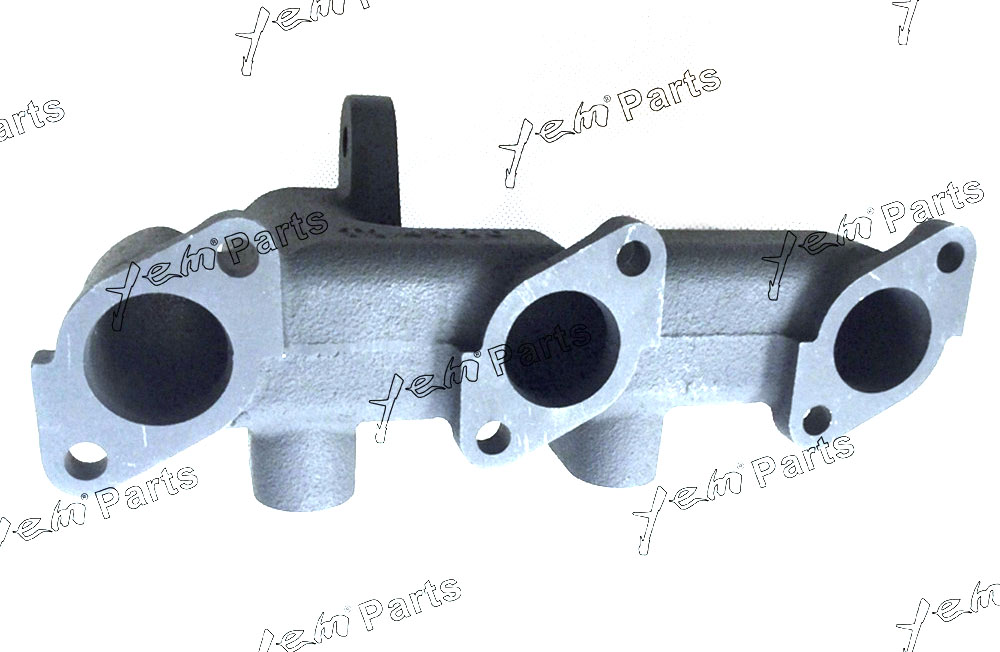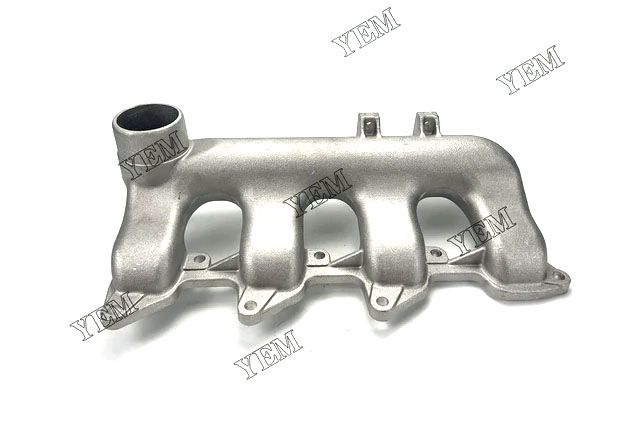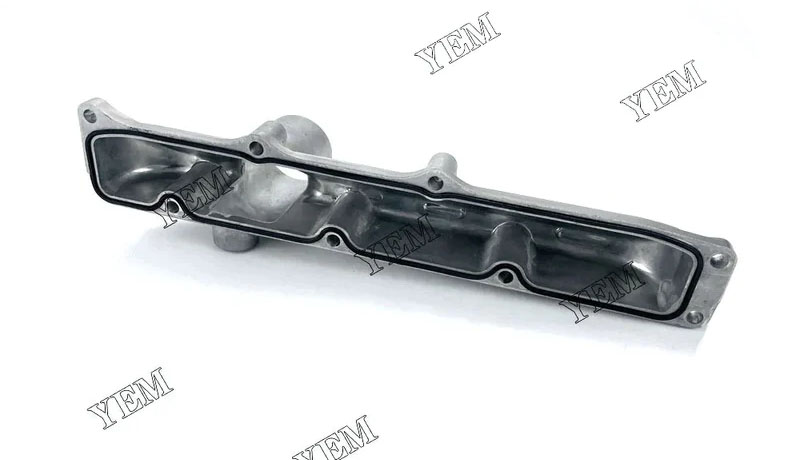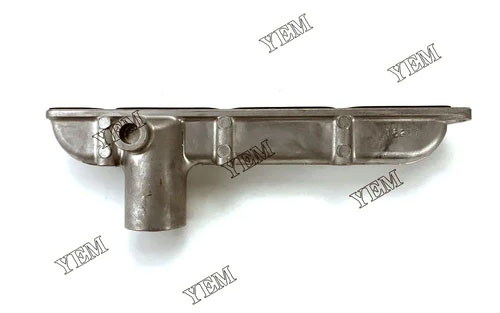The function and principle of the intake branch pipe
The intake branch pipe plays a crucial role in the operation of an engine. Its main function is to deliver air from the intake manifold to the combustion chamber of each cylinder. Here are the key functions and principles of the intake branch pipe:
- Air Distribution: The intake branch pipe is designed to distribute air evenly among the cylinders of the engine. This ensures that each cylinder receives an adequate supply of air for combustion.
- Smooth Airflow: The design of the intake branch pipe aims to provide a smooth and uninterrupted airflow. It minimizes turbulence and restrictions to optimize the flow of air into the cylinders.
- Air Filtration: In most engines, the intake branch pipe includes an air filter element. This helps to remove dirt, dust, and other contaminants from the incoming air, protecting the engine from potential damage.
- Tuning and Resonance: In certain engine designs, the length and shape of the intake branch pipe can be tuned to optimize engine performance at specific RPM ranges. This can enhance torque, power delivery, and overall engine efficiency.
- Acoustic Resonance: The intake branch pipe, along with other intake components, can be designed to create acoustic resonance or tuned intake sound. This can enhance the sound of the engine, providing a more satisfying driving experience.
The principles behind the design of the intake branch pipe focus on maximizing airflow efficiency, minimizing restrictions, and optimizing the air/fuel mixture for proper combustion. It is an essential component in the intake system, working together with other intake components to ensure the engine runs smoothly and efficiently.

Comparison of different intake branch pipe designs
When comparing different intake branch pipe designs, there are several factors to consider. Here are some aspects to compare:
- Shape: Intake branch pipes can have different shapes, such as straight, curved, or multiple bends. Each shape has its advantages and disadvantages in terms of airflow characteristics, turbulence reduction, and packaging considerations.
- Material: Intake branch pipes are typically made of materials like plastic, aluminum, or composite materials. The choice of material can impact factors such as weight, heat resistance, durability, and manufacturing cost.
- Diameter and Length: The diameter and length of the intake branch pipe can affect the airflow velocity and distribution to each cylinder. Tuning the pipe length can optimize performance at specific RPM ranges.
- Smoothness: Smooth internal surfaces of the intake branch pipe minimize airflow turbulence and restrictions, allowing for better airflow and improved engine performance. Some designs incorporate features like internal coatings or honing to enhance smoothness.
- Heat Insulation: Some intake branch pipes feature heat insulation properties to reduce heat transfer from the engine, which can help improve intake air temperature and density. This can enhance performance by providing cooler, denser air to the combustion chambers.
- Variable Geometry: Advanced intake systems may include variable geometry intake branch pipes that can adjust their dimensions based on engine speed or load. This optimization allows for improved performance across a wider range of operating conditions.
When comparing intake branch pipe designs, it is important to consider their compatibility with the specific engine and the intended use of the vehicle. Factors such as performance goals, emissions regulations, and budget should also be taken into account. Ultimately, the optimal intake branch pipe design will depend on the desired balance of performance, efficiency, and cost for the given application.

Intake branch pipe modification technology
Intake branch pipe modification technology refers to techniques and methods used to improve the performance and efficiency of the intake system in an engine. Here are some common intake branch pipe modification technologies:
- Porting and polishing: This technique involves modifying the internal surfaces of the intake branch pipe to improve airflow. Porting involves reshaping and enlarging the intake ports and runners, while polishing smooths the surfaces to reduce turbulence. These modifications can increase airflow velocity and enhance engine performance.
- Cold air intake: A cold air intake system replaces the stock intake branch pipe with a larger-diameter pipe and a high-flow air filter. It aims to bring cooler and denser air from outside the engine bay into the combustion chambers, improving combustion efficiency and potentially increasing power output.
- Heat insulation: Insulating the intake branch pipe helps to reduce heat transfer from the engine, which can lead to lower intake air temperatures. Cooler air is denser, allowing for improved combustion and increased power. Heat insulation materials like thermal wraps or ceramic coatings are commonly used for this purpose.
- Variable intake geometry: Some advanced intake systems incorporate variable intake branch pipes that can adjust their length or shape based on engine speed or load conditions. This technology optimizes the airflow to match the engine’s requirements at different RPM ranges, improving torque, power, and fuel efficiency.
- Intake manifold spacer: Intake manifold spacers are inserted between the intake manifold and the intake branch pipe. They increase the plenum volume, which can improve mid-range torque and throttle response. Additionally, the spacers can act as thermal barriers, reducing heat transfer between the engine and the intake manifold.
- Tuned-length intake branch pipes: These branch pipes are specifically designed to match the engine’s intake pulse characteristics. By optimizing the length and diameter of each runner, tuned-length intake branch pipes can enhance cylinder filling and maximize engine performance at specific RPM ranges.
It’s important to note that these modifications may require tuning and calibration to achieve the desired results without compromising engine reliability. Additionally, the effectiveness of each modification can vary depending on the specific engine design and the overall intake system configuration. Consulting with experts or researching specific applications is recommended before modifying the intake branch pipe or any other engine components.
Inlet manifold maintenance and troubleshooting
Maintaining and troubleshooting the inlet manifold (also known as the intake manifold) is crucial for the proper functioning of an engine’s intake system. Here are some maintenance and troubleshooting tips for the inlet manifold:

Maintenance:
- Regular cleaning: Over time, carbon deposits, dirt, and oil can accumulate inside the inlet manifold. Regularly cleaning the manifold helps maintain proper airflow and prevent obstructions. Use a suitable intake manifold cleaner or a mixture of warm water and mild detergent to clean the interior. Avoid using abrasive materials that can damage the surfaces.
- Check for leaks: Inspect the inlet manifold for any signs of leaks, such as visible cracks, loose connections, or damaged gaskets. Leaks can affect engine performance and lead to issues like poor fuel economy, rough idling, or hesitation during acceleration. Replace any faulty gaskets or seals and tighten connections as necessary.
- Inspect for clogs: Look for obstructions or clogs in the inlet manifold, including the intake runners and plenum chamber. Clogs can restrict airflow and decrease engine performance. If you notice significant build-up or blockages, consider professional servicing or use specialized cleaning products to remove stubborn deposits.
Troubleshooting:
- Rough idling or hesitation: If the engine idles roughly or hesitates during acceleration, it could be a sign of an intake manifold issue. Check for vacuum leaks, such as cracked manifold, loose connections, or damaged intake manifold gaskets. Address any leaks promptly to restore proper airflow.
- Misfires or decreased power: Intake manifold issues can cause misfires or a loss of power. Inspect the throttle body, intake runners, and sensors for signs of damage or clogging. Make sure the throttle plate moves freely. Clean or replace components as needed, and ensure proper sensor functionality.
- Intake air temperature (IAT) sensor problems: The IAT sensor measures the temperature of the incoming air to adjust fuel injection and ignition timing. Faulty IAT readings can cause performance issues. Test the IAT sensor for proper operation using a multimeter or consult a professional if needed. Replace any malfunctioning sensors.
- Unusual engine noise: A damaged or cracked inlet manifold can create a vacuum leak, leading to an abnormal hissing or sucking noise. Inspect the manifold for visible cracks or damage, and address any issues promptly to prevent further damage or performance loss.
- Engine codes or warning lights: Inlet manifold issues may trigger diagnostic trouble codes (DTCs) or illuminate warning lights on the dashboard. Use a diagnostic scanner to retrieve and interpret these codes. This information can help pinpoint specific problems and guide the troubleshooting process.
If you’re unsure or uncomfortable with inlet manifold maintenance or troubleshooting, it’s recommended to consult a qualified mechanic or technician who has experience with your specific engine model. They can provide professional guidance and assistance to ensure proper maintenance and resolution of any issues.
Latest intake manifold technology and trends

The latest intake manifold technology and trends focus on improving engine performance, efficiency, and emissions. Here are some notable advancements:
- Direct Injection: Many modern engines utilize direct fuel injection, which delivers fuel directly into the combustion chamber. This technology allows for better control over fuel delivery, resulting in improved performance and fuel efficiency.
- Variable Intake Manifold Systems: Variable-length intake manifolds adjust the length of the intake runners to optimize air flow at different engine speeds. This helps to enhance torque output across a wide RPM range.
- Composite Materials: Manufacturers are increasingly using composite materials, such as plastic or carbon fiber-reinforced polymer, to construct intake manifolds. These materials offer weight reduction, improved thermal efficiency, and reduced vibrations compared to traditional metal manifolds.
- Active Intake Manifold Flaps: Some intake manifolds feature electronically controlled flaps that can open or close to regulate airflow. This helps to improve low-end torque and high-end power by optimizing the intake airflow dynamics.
- Integrated Runner Control: Integrated runner control systems provide even more precise control over airflow by independently controlling each intake runner’s length and diameter. This allows for further optimization of engine performance at various operating conditions.
- Thermal Management: Intake manifolds with integrated internal cooling systems, such as coolant passages or heat exchangers, help manage intake air temperature. By reducing heat soak and keeping the incoming air cooler, engine efficiency and performance can be improved.
- Hybrid Intake Manifold Designs: Some manufacturers are exploring hybrid intake manifold designs that combine traditional port fuel injection with direct injection. This approach aims to leverage the benefits of both systems for improved overall engine performance and fuel efficiency.
Overall, the latest trends in intake manifold technology focus on maximizing engine efficiency, power output, and emission control through advanced materials, design innovations, and electronic control systems.
YEM Professional Excavator Parts Team is a reliable and experienced team focused on providing high-quality excavator parts. Leveraging our extensive expertise in this field, we offer a diverse selection of components to meet various customer needs.
Whether you need replacement parts for hydraulic systems, engine parts, chassis parts, or any other excavator component, the YEM team can meet your needs. We source our products from reputable manufacturers, ensuring every part meets the highest standards of quality and durability.
What sets us apart is our unwavering commitment to exceptional customer service. We understand the importance of prompt support and strive to respond promptly to inquiries and requests. Our knowledgeable staff is available to assist customers in determining the correct parts needed for their specific excavator model and provide installation and maintenance instructions.
To contact YEM’s professional excavator parts team, you can get in touch via our website, email or phone. We are committed to building long-term relationships with our customers and are passionate about assisting you with all your excavator parts needs.
